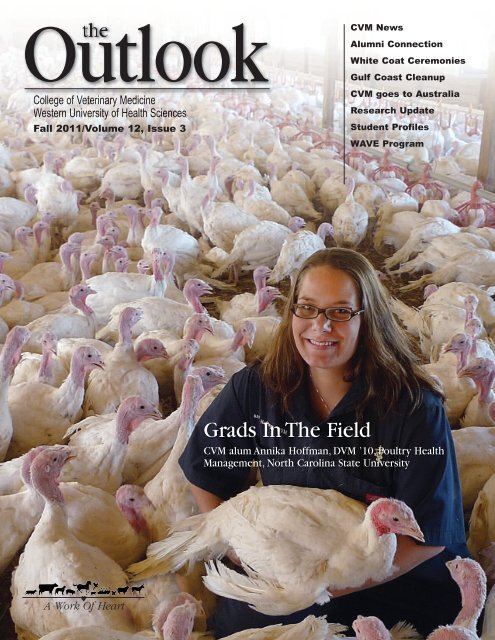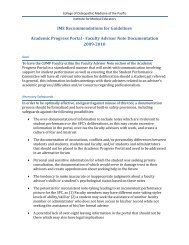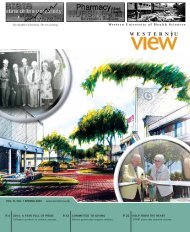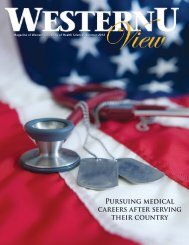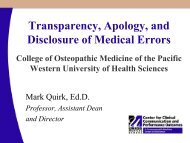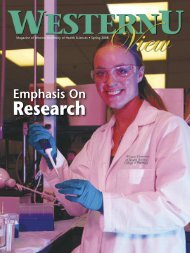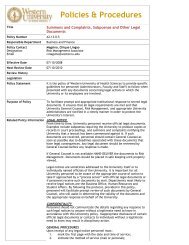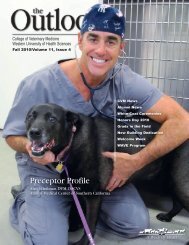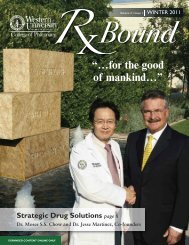The Outlook - Western University of Health Sciences
The Outlook - Western University of Health Sciences
The Outlook - Western University of Health Sciences
- No tags were found...
You also want an ePaper? Increase the reach of your titles
YUMPU automatically turns print PDFs into web optimized ePapers that Google loves.
<strong>Outlook</strong>theCollege <strong>of</strong> Veterinary Medicine<strong>Western</strong> <strong>University</strong> <strong>of</strong> <strong>Health</strong> <strong>Sciences</strong>Fall 2011/Volume 12, Issue 3CVM NewsAlumni ConnectionWhite Coat CeremoniesGulf Coast CleanupCVM goes to AustraliaResearch UpdateStudent Pr<strong>of</strong>ilesWAVE ProgramGrads In <strong>The</strong> FieldCVM alum Annika H<strong>of</strong>fman, DVM ’10, Poultry <strong>Health</strong>Management, North Carolina State <strong>University</strong>A Work Of Heart
W o r d f r o m t h e D e a n<strong>The</strong>se are exciting times to be part <strong>of</strong> <strong>Western</strong><strong>University</strong> <strong>of</strong> <strong>Health</strong> <strong>Sciences</strong>. <strong>The</strong> Class <strong>of</strong> 2015 thatstarted in August totals more than 1,100 first-yearstudents – 105 <strong>of</strong> them in the College <strong>of</strong> VeterinaryMedicine – the largest entering class in the 34-yearhistory <strong>of</strong> <strong>Western</strong>U. That brings the <strong>University</strong>’s totalenrollment to more than 3,200 for this academicyear – another record.In addition, the <strong>University</strong> opened a new campus inLebanon, Ore. COMP-Northwest welcomed itsinaugural class <strong>of</strong> 107 in late July, helping to expandthe <strong>Western</strong>U world to the Pacific Northwest.In the CVM family, our faculty members have beenpart <strong>of</strong> exciting projects at the Museum <strong>of</strong> NaturalHistory in Los Angeles and involved with theinaugural International One <strong>Health</strong> Congress inMelbourne, Australia. Both are highlighted in thisissue <strong>of</strong> the <strong>Outlook</strong>.Plus, as we close out World Veterinary Year, which marked 250 years <strong>of</strong> veterinarymedicine, I want to thank Dr. Ana Alcaraz for spearheading our campus efforts tocommemorate this important occasion. Be sure to check out the calendar she and herteam put together. It provides a fascinating look at veterinary medicine through theyears.Finally, I would like to join with Dr. Philip Pumerantz, president <strong>of</strong> <strong>Western</strong>U, incongratulating the following CVM faculty and staff on their milestone employment:• Administrative Assistant for the Associate Dean for Faculty Affairs,Chris VanderVeen 15 years• Associate Pr<strong>of</strong>essor, Christine Green, BVSc, MRCVS, 5 years• Associate Dean for Academic Affairs Teresa Morishita, DVM, MPVM, MS, PhD, DACPV,5 years• Assistant Pr<strong>of</strong>essor Kristopher Irizarry, PhD, 5 years.I look to the future – and this new academic year – with a renewed appreciation for ourpr<strong>of</strong>ession and with the knowledge that through the expert guidance <strong>of</strong> our faculty andstaff, our students will become remarkable healers.the<strong>Outlook</strong>Fall 2011/Volume 12, Issue 3College <strong>of</strong> Veterinary Medicine<strong>Western</strong> <strong>University</strong> <strong>of</strong> <strong>Health</strong> <strong>Sciences</strong>Editor:Paul Gordon-Ross, DVM, MS909.706.3529pgordon@westernu.eduAssociate Editor:Carla Sanderscarlasanders3@aol.comAssistant Editor:Jason Carter909.706.3874jcarter@westernu.eduPhotographer:Jess Lopatynski909.469.5298jlopatynski@westernu.eduPhotographer:Jeff Malet909.469.3790jmalet@westernu.eduGraphic Designer:Paul Gettler909.469.5256pgettler@westernu.edu------309 E. Second St.Pomona, Calif. 91766-1854www.westernu.eduCVM<strong>Outlook</strong>@westernu.edu.A Work Of HeartO n T h e C o v e rAnnika H<strong>of</strong>fman, DVM ’10, second-year Poultry <strong>Health</strong>Management at North Carolina State <strong>University</strong>Photo courtesy <strong>of</strong> Annika H<strong>of</strong>fmanPhillip Nelson, DVM, PhD2If you would like to be removed from the<strong>Outlook</strong> mailing list contact Liz McGowen at909.469.5392 or email mmcgowan@westernu.edu
White Coats Donned at Annual CeremonyAMID CHEERING AND APPLAUSE from family andfriends, the 105 members <strong>of</strong> the new CVM Class<strong>of</strong> 2015 received their white coats during theannual White Coat Ceremony on Aug. 6 at OntarioConvention Center.Keynote speaker John Payne, president and chiefexecutive <strong>of</strong>ficer <strong>of</strong> Banfield, <strong>The</strong> Pet Hospital, toldthe more than 500 people assembled in BallroomA that veterinary medicine “is the greatestpr<strong>of</strong>ession on Earth.” To the new class he saidthey have an “awesome responsibility … to makeveterinary medicine even better than it is today,and it’s already fantastic!”He intoned the incoming class to take care <strong>of</strong>themselves during the next four years <strong>of</strong> rigorousstudy so they may go on to become healthy,productive veterinarians. He noted that the facultymembers at <strong>Western</strong>U’s CVM “are here to help andguide you.”“<strong>The</strong> demand for veterinary medicine has neverbeen stronger and will continue to be strong,” hereported. “This is a great time to be a vet, and infour years’ time, it’s even going to be better. Youhave a great future ahead <strong>of</strong> you.” He urged theclass to “do everything you can to make sureveterinary medicine grows and flourishes.”<strong>The</strong> White Coat Ceremony followed the Convocation, whichpacked about 3,500 people – incoming students from<strong>Western</strong>U’s nine colleges, plus family and friends – into themain Exhibit Hall <strong>of</strong> the Convention Center. <strong>The</strong> keynoteaddress was delivered by Herb Schultz, who was appointed in2010 by President BarackObama to serve as theRegion IX director for theUS Department <strong>of</strong> <strong>Health</strong>and Human Services. <strong>The</strong>diverse Region IX coversArizona, California, Nevada,and Hawaii; the territories<strong>of</strong> American Samoa,Commonwealth <strong>of</strong> theNorthern Mariana Islands,CVM’s Class <strong>of</strong> 2015and Guam, and the freely associated states <strong>of</strong> the FederatedStates <strong>of</strong> Micronesia, Republic <strong>of</strong> Marshall Islands, and Republic<strong>of</strong> Palau. Previously, Schultz served as a senior health policyadvisor to former California Gov. Arnold Schwarzenegger.Such diversity is important to Schultz, who noted during hisaddress that <strong>Western</strong>U’s academic diversity, as well as thesociocultural diversity <strong>of</strong> its student body, is a tremendous assetin the health-care world.“One <strong>of</strong> the things I love about <strong>Western</strong>U is that you representAmerica. You represent the people you will serve,” he said.Remembering that those patients are what matters mostshould allow all involved in the health-care debate to look pastpartisan politics and find a clear path to better health care foreveryone, he concluded. “Politics to me is about working withyou to make change happen.”<strong>Western</strong>U Enrollment Sets Record<strong>The</strong>morethan1,100first-yearstudentsat<strong>Western</strong><strong>University</strong><strong>of</strong><strong>Health</strong><strong>Sciences</strong>markthelargest-everenteringclassin<strong>Western</strong>U’shistory,whichbeganin1977andincludedaninitialclass<strong>of</strong>just36osteopathicstudentsin1978.<strong>The</strong>size<strong>of</strong>theincomingclass<strong>of</strong>futureosteopathicphysicians,pharmacists,nurses,veterinarians,physicianassistants,physicaltherapists,dentists,optometrists,podiatristsandbiomedicalscholarspushedthe<strong>University</strong>’stotalenrollmentpast3,200forthe2011-12academicyear–anotherrecord.4
CVM Student ChroniclesGulf Coast CleanupIn the weeks after the Deepwater Horizon oil rig exploded in the Gulf <strong>of</strong> Mexico in April, 2010, news reportsshowed an environmental tragedy in the making. Those images and the stories coming out <strong>of</strong> the Gulf spurredto action thousands <strong>of</strong> volunteers, one <strong>of</strong> whom was a first-year student in the College <strong>of</strong> Veterinary Medicine.“A lot <strong>of</strong> what was happening downthere wasn’t being covered,” saysHeather Rally, DVM 2014, who headedto Alabama and Louisiana with tw<strong>of</strong>riends to make a documentary aboutthe effects <strong>of</strong> the spill. “We wanted toget out the stories <strong>of</strong> the people.”What she expected to be a two-weekproject turned into a year-long mission tochronicle the lives <strong>of</strong> those most affectedby the spill and its aftermath, includingfishermen, cleanup workers, and others. “Itbecame really personal, really quickly. It waslike we were experiencing this with them,”says Heather who, after starting with theClass <strong>of</strong> 2013, deferred veterinary school fora year to work on “Project Gulf Impact.”Among the stories were reports <strong>of</strong> sea turtles being burned aliveand cleanup workers along the shore not being allowed to wearthe proper respiratory equipment because local <strong>of</strong>ficials fearedfrightening <strong>of</strong>f tourists. Heather says they should have beenfrightened anyway: “the beach was toxic.” Like many others there,Heather and her friends landed in the hospital, sickened, she says,by the oil and Corexit, a chemical dispersant that was being usedon the oil too close to shore.<strong>The</strong> film, stilled dubbed the “<strong>The</strong> PGI Documentary,” is in the finalediting stages. Heather and “<strong>The</strong> Team” hope to submit the filmduring the upcoming festival season, and find a distributor so thefilm can be seen by a broader audience. “<strong>The</strong> work there isongoing,” she says. “Every day for them is a constant struggle.”This wasn’t Heather’s first foray into filmmaking. Previously sheworked, partly undercover, with the film crew responsible for thedocumentary, “<strong>The</strong> Cove,” which told <strong>of</strong> dolphin slaughter in Japanand how that dolphin meat makes its way to other parts <strong>of</strong> theworld. “<strong>The</strong> Cove” went on to win the 2010Academy Award for Best Documentary.Born and raised in Santa Monica, Heather’sinterest in “anything creepy crawly” began as achild. She says she had a menagerie by the age <strong>of</strong>3 or 4 years old and says, “I have always known Iwanted to work with animals, and have alwayshad a particularly strong connection with theocean.” She completed her undergraduate workin Biology at the <strong>University</strong> <strong>of</strong> California, SantaBarbara, in 2009, and has worked at the Channel Islands Marineand Wildlife Institute and the Marine Mammal Care Center at FortMacArthur, among other places.She remains in contact with her Gulffriends. “It was a pretty amazingexperience,” she recalls now. “Despitethe devastation and uncertainty, whatI witnessed was an incrediblyorganic and beautiful comingtogether <strong>of</strong> the community.”7
C V M S t u d e n t P r o f i l e s - C l a s s o f 2 0 1 5Charlotte JordanOriginally from Northern California, I have beenliving the past eight years in San Diego where Iearned my BS in Biology from the <strong>University</strong> <strong>of</strong>California, San Diego. After graduation I workedin a regenerative medicine production lab aswell as a small animal veterinary clinic. I aminterested in small animal medicine.Audrey KeebaughI grew up in Pomona and Chino Hills, Calif.,and I received my Bachelor's degree inNeurobiology from the <strong>University</strong> <strong>of</strong>California, Irvine. I did undergraduateresearch in spinal cord regeneration,volunteered at an animal shelter andworked at a cats-exclusive practice. I aminterested in small animal surgery.I’ve lived in Reno, Nev., for most <strong>of</strong> mylife and received a Bachelor’s in AnimalScience from the <strong>University</strong> <strong>of</strong> Nevada,Reno. I worked in a small animal practiceduring my studies and then in a researchlaboratory afterwards. I’m interested inlarge animal medicine and research.Phoebe KempI was raised in Manhattan Beach andreceived a BS in Animal Science and a Minorin Music from California Polytechnic State<strong>University</strong>, San Luis Obispo. While at CalPoly, I was a music teacher and a surgerytechnician for a local animal shelter. I aminterested in small animal medicine.Marc LedesmaKevin LewBorn and raised in Los Angeles, I earned myBachelor’s degree in Integrative Biology from the<strong>University</strong> <strong>of</strong> California at Berkeley. I worked for asmall animal practice that <strong>of</strong>fered traditional andholistic approaches. My undergraduate researchincluded behavioral ecology and embryonicsignaling. I am interested in small animal medicine.Kelly McCurryI was born and raised in the Central Valley<strong>of</strong> California, and received my Bachelor'sdegree in Animal Science from CaliforniaState <strong>University</strong>, Fresno. I have worked insmall animal clinics since 16, and plan tocontinue my education with an emphasis insmall animal and exotic medicine.I have lived in State College, Pa., my wholelife and received my Bachelor’s degree inAnimal <strong>Sciences</strong> from <strong>The</strong> PennsylvaniaState <strong>University</strong>. I have worked at a smallanimal hospital for almost five years now. Iam interested in small animal medicinewith a focus on cats and dogs.Kurt MichelottiAfter leaving my hometown <strong>of</strong> ClintonTownship, Mich., I departed for Adrian College.<strong>The</strong>re I received my Bachelor’s degree inBiology and English writing. I volunteered atvarious small animal clinics, and worked at theJohn Ball Zoo in Grand Rapids, Mich. I find zooand wildlife medicine especially alluring.Kate MooreSue MowattFollowing a successful business career, I wasinspired to pursue veterinary medicine whilevolunteering at a wildlife rescue facility inNorthern California. I’ve interned at a shelter andfarm animal sanctuary and have volunteered atequine facilities. I am interested in becoming arural mobile vet and continuing volunteer efforts.Evelyn NgoI grew up in San Diego and graduatedwith a Bachelor’s degree in Biologyfrom San Diego State <strong>University</strong>. I haveworked for a small animal practice(dogs and cats) and I have volunteeredat my local animal shelter and at anemergency animal hospital. I aminterested in small animal medicine.11
RESEARCHUpdateAssistant Pr<strong>of</strong>essor Babak Faramarzi, DVM,MSc, CVA, PhD, received a research grant fromthe Arabian Horse Foundation for the study <strong>of</strong>equine ho<strong>of</strong> interactions with the ground surfaceand the impact <strong>of</strong> trimming and ho<strong>of</strong>conformation. <strong>The</strong> award is the first for the<strong>Western</strong>U CVM from the foundation. Dr.Babak Faramarzi Faramarzi’s grant was one <strong>of</strong> only three researchgrants given by the foundation for 2011. <strong>The</strong>other two were awarded to UC Davis and Cornell <strong>University</strong>. <strong>The</strong>Arabian Horse Foundation is the philanthropic arm <strong>of</strong> the ArabianHorse Association and supports three funding areas: YouthScholarships, Equine Research, and Rescue and Rehoming.Veterinary Assistant Pr<strong>of</strong>essor HrvojeSmodlaka, DVM, PhD, presented hiscollaborative work to the American Association<strong>of</strong> Veterinary Anatomists at their annual meetingat Cornell <strong>University</strong>, Aug. 6-8, 2011. This workdescribes skin histology, physiology and skinthermal emissivity in pinnipeds (Pacific Oceanseals and California sea lions). This work is aHrvoje Smodlakaresult <strong>of</strong> close collaboration between CVMPr<strong>of</strong>essor Wael Khamas, BVMS, MS, PhD andDr. Smodlaka, with <strong>Western</strong>U alumna Dr. JessicaLeach-Robinson and a colleague at MarineMammal Care Center in San Pedro, Calif., Dr.Lauren Palmer. <strong>The</strong> complete citation is:Histology and infrared thermography <strong>of</strong> the skin,skin appendages and their role in heatdissipation in three pinniped species. Khamas W,Wael KhamasSmodlaka H, Leach-Robinson L, Palmer L”.In addition, Dr. Khamas and alumnus Richard Reeves, DVM ’09,have published a manuscript. This collaboration between facultyand a student (now alumnus) serves as a reminder <strong>of</strong> theenrichment that scholarly effort brings to the curriculum and thepr<strong>of</strong>ession. <strong>The</strong> complete citation is: Khamas W and Reeves R.Morphological Study <strong>of</strong> the Oesophagus and Stomach <strong>of</strong> theGopher Snake Pituophis catenifer. Journal <strong>of</strong> VeterinaryMedicine, Anat. Histol. Embryol. 2011:40:307–313.<strong>The</strong> inaugural issue <strong>of</strong> Today’s Veterinary Practice features anarticle on the diagnosis <strong>of</strong> canine heartworm infection by theCVM’s Peggy Barr, DVM, PhD, Peggy Schmidt, DVM, MS,DACVPM, Beth Boynton, DVM, Frank Bossong, DVM, andGary Johnston, DVM, MS, DACVR. <strong>The</strong> complete citation is:Barr MC, Boynton EP, Schmidt PL, Bossong F, Johnston GR.Diagnosis <strong>of</strong> canine heartworm infection. Today’s Vet Practice2011;1(1):30-37.Veterinary Assistant Pr<strong>of</strong>essor Pedro Diniz,DVM, PhD, authored two sections in the recentsecond edition <strong>of</strong> “Clinical Veterinary Advisor:Dogs and Cats” by Etienne Cote. <strong>The</strong> sections,titled “Anaplasmosis” and “Canine MonocyticEhrlichiosis,” are products <strong>of</strong> Dr. Diniz’s researchand clinical interests. <strong>The</strong> complete citation forthis book is: Cote E. Clinical Veterinary Advisor:Dogs and Cats. 2nd ed. Canada: Mosby; 2011.Pedro DinizDr. Diniz also published a scholarly review and national survey <strong>of</strong>Erlichia infection in dogs in Brazil. <strong>The</strong> international team <strong>of</strong>collaborators includes scientists from eight prestigious institutionsincluding <strong>Western</strong>U. <strong>The</strong> complete citation is: Vieira RF et al.Erlichiosis in Brazil. Rev. Bras. Parasitol. Vet., Jaboticabal, 2011Jan-Mar; 20(1):1-12.In addition, Dr. Diniz published a case report on a new infectiousagent with zoonotic significance. Candidatus Neoehrlichiamikurensis is a new intracellular pathogen associated with humaninfection and death. <strong>The</strong> report describes CandidatusNeoehrlichia mikurensis infection in a chronically neutropenicdog from Germany that was confirmed by DNA sequencing. <strong>The</strong>same organism was previously described from ticks and two sickhumans from Germany. <strong>The</strong> complete citation is: Diniz, PPVP, et al.Candidatus Neoehrlichia mikurensi: Infection in a Dog fromGermany. Journal <strong>of</strong> Clinical Microbiology. 2011 May: 2059–2062.JOB FAIRNovember 3 & 4, 2011Interview This Year’s Graduating Class for Internship or Associate Positions andTour the College <strong>of</strong> Veterinary MedicineCall or email for information, Jason Carter at 909-469-3874 or jcarter@westernu.edu*RSVP RequiredEvent Location: 505 E. Second Street, Pomona, Calif.14
R E S E A R C HCVM Quartet AttendsOne <strong>Health</strong> CongressinIN FEBRUARY 2011, THE CITY OF MELBOURNE, AUSTRALIA, hosted the1st International One <strong>Health</strong> Congress, with the theme: “Human<strong>Health</strong>, Animal <strong>Health</strong>, the Environment and Global Survival.”Three faculty members from the College <strong>of</strong> Veterinary Medicine,Helen Engelke, BVSc, MPVM, MRCVS, Tracey McNamara, DVM,DACVP, and Suzana Tkalcic, DVM, PhD, along with Gaël Lamielle,DVM, a 2009 graduate, represented <strong>Western</strong>U.At this pivotal meeting, more than 650 like-minded One <strong>Health</strong>proponents shared their experiences to broaden the agenda <strong>of</strong>One <strong>Health</strong> into a global perspective and to enhance crosscollaborativeefforts <strong>of</strong> public health, environmental health, andveterinary medicine. <strong>The</strong> goal was to develop a collaborativestrategy to address major global public health issues and to ploteffective pathways for the One <strong>Health</strong> community to reach “healthfor all in the 21st century.” All <strong>of</strong> the <strong>Western</strong>U representatives feltstrongly the need to wave the flag high for the <strong>University</strong>, tointroduce an international audience to our strengths and ourmodels.Dr. McNamara, a pr<strong>of</strong>essor in veterinary pathology, had no doubtshe would attend this meeting. “I wanted to connect with otherOne <strong>Health</strong> practitioners, to find out what they were doing and toexplore more ways forward,” she said. Her two papers, “A Bird inthe Hand: the Power <strong>of</strong>Zoo Sentinels” and “<strong>The</strong>Russian Anti-PlagueSystem: An OverlookedZoonotic DiseaseSurveillance andResponse System,” bothwere incredibly wellreceived and challengedattendees to reevaluatetraditional thinking.Dr. Engelke, an assistantpr<strong>of</strong>essor in veterinarypublic health, said she“felt very strongly thatacademia be represented, that if we are to afford long-term changein our approach to the human-animal interface, we need toremold the education <strong>of</strong> all <strong>of</strong> our health pr<strong>of</strong>essionals.” Herpresentation: “Inter Pr<strong>of</strong>essional Education: A Novel CurriculumBridging the Educational Divide <strong>of</strong> Medical, Veterinary and other<strong>Health</strong> Pr<strong>of</strong>essional Students,” spoke to that belief.Through her oral presentation: “Paving the Road to One <strong>Health</strong>:Veterinary Medicine and Interpr<strong>of</strong>essional Education,” Dr. Tkalcic,an assistant pr<strong>of</strong>essor in veterinary pathology, introduced existing<strong>Western</strong>U IPE programs and suggested a model for restructuringinternship and externship programs for health pr<strong>of</strong>essionaleducation into a more inclusive interpr<strong>of</strong>essional team-basedapproach. She also actively participated in the InternationalFrom left, Dr. Engelke, Dr. McNamara, Dr. Lamielle and Dr. Tkalcicenjoy the One <strong>Health</strong> Congress in Australia.Society for One <strong>Health</strong> initiative and in the discussion for definingoutreach and communication strategies for a “one health”approach to a wide medical community.Dr. Lamielle further advocated for how the <strong>Western</strong>U model cantranslate into positive health outcomes. His paper, “CysticEchinococcosis Prevention in the Highlands <strong>of</strong> Peru – AMultidisciplinary Perspective,” showcased the university’s teambasedinterpr<strong>of</strong>essional approach to this important but neglectedzoonosis. He also presented his One <strong>Health</strong> internationalexperience through the <strong>Western</strong>U Center for Global andCommunity <strong>Health</strong> scheduled clinical externship.<strong>The</strong> Congress gathered a large scientific community <strong>of</strong> healthpr<strong>of</strong>essionals around one idea: How to more efficiently preservehuman and ecosystem health in the modern world. It had strongattendance from the medical community and there appeared to bereal “buy in” from key political figures. To keep the momentumand enthusiasm generated, the next meeting is scheduled forBangkok, Thailand in 2013.Dr. McNamara attended a follow-up meeting in London in Junefrom which steps were identified and defined for making One<strong>Health</strong> a reality. And certainly attendees, while enjoying the beauty<strong>of</strong> the banks <strong>of</strong> the Yarra River in Melbourne did get the message:“We may be in Melbourne now, but <strong>Western</strong>U is where it’s allhappening!”Speaking <strong>of</strong> global health, here is an example <strong>of</strong> how our facultynever sleeps. While at the Sydney airport, Dr. Tkalcic drafted aveterinary clinic from Barry, outside Sydney, to join our 4th yearinternational clinical rotation sites. For our DVM studentsinterested in the veterinary world from “down under,” here isyour chance!15
C V M N e w sJoe BertonePr<strong>of</strong>essor Joe Bertone, DVM, MS, DACVIM,recently was named chief medical editor forEquus magazine. This widely circulatedpublication is billed by Amazon.com asproviding “the latest information from theworld's top veterinarians, equine researchers,riders and trainers on understanding andinfluencing equine behavior, recognizing thewarning signs <strong>of</strong> illness and disease, and solvingriding and training problems.”In addition Dr. Bertone was an invited speaker at the CentralVeterinary Conference, Washington, DC, edition on May 4–5, 2011.He presented the following topics at this meeting: “Clinical neurologymade easy - Part 1,” “Clinical neurology made easy - Part 2,” “Sleepdeprivation: it’s not narcolepsy,” “Dorsal cervical articular injection:when and how,” “Cardiac evaluation and case discussion,” “Medicinecase discussion,” and “Occult and flagrant pleuropneumonia.”Veterinary Assistant Pr<strong>of</strong>essor Helen Engelke,BVSc, MPVM, MRCVS, has been certified as aPreventive Medicine specialist by the AmericanCollege <strong>of</strong> Veterinary Preventive Medicine(ACVPM). <strong>The</strong> certification exam encompassesfive areas <strong>of</strong> specialty: infectious and parasiticdiseases, food safety, environmental health &toxicology, epidemiology & biostatistics, andpublic health administration. Dr. Engelkepassed all five parts <strong>of</strong> the exam and joins theranks <strong>of</strong> 680 active Diplomates in thisHelen Engelkeexclusive specialty college. This year’s exam pass rate was 56 percent,which included veterinarians taking the exam for the first, second,third and fourth times.Veterinary Assistant Pr<strong>of</strong>essor YvonneDrechsler, MS, PhD, and Pr<strong>of</strong>essor EllenCollisson, MS, PhD, presented at the 12thInternational Nidovirus Symposium at Acme,Mich., on June 4-9, 2011. Dr. Drechsler gave anoral presentation, “Greater macrophageresponse <strong>of</strong> B2 MHC chickens correlates withgreater resistance to coronavirus associatedillness,” by Yvonne Drechsler, Maisie Dawes,Ghida R. Banat, Suzana Tkalcic, Mark W.Yvonne DrechslerJackwood, Lisa Griggs, W. Elwood Briles andEllen Collisson. Dr. Collisson presented a poster, “Genetic resistance toAvian Coronavirus can be associated with the avian MHC,” by Ghida R.Banat, Suzana Tkalcic, W.E. Briles, Miguel D. Saggese, Mark W. Jackwoodand Ellen W. Collisson. <strong>The</strong> chicken’s major histocompatibility complex(MHC) haplotype is known to have pr<strong>of</strong>ound influence on theresistance or susceptibility to certain pathogens.Maria Pia PhillipsA Red Cross blood drive in honor <strong>of</strong> the lateMaria Pia Phillips, PhD, was held on Aug.22, 2011 in BVCC Commons. All participantsreceived a coupon for a box <strong>of</strong> chocolatecoveredfruit from Edible Arrangements, twocomplimentary VIP tickets to the LaughFactory and a voucher for two tickets for aChivas soccer game, plus were entered into adrawing for a $500 gas card.As an avid proponent <strong>of</strong> comparative medicine/pathology and a longtermsupporter <strong>of</strong> the global One <strong>Health</strong> initiative, CVM AssistantPr<strong>of</strong>essor Suzana Tkalcic, DVM, PhD, frequently returns to hernative Croatia as an invited speaker and session chair for the Annual“Ljudevit Jurak” International Symposiums on Comparative Pathology.<strong>The</strong> event takes place in the capital city <strong>of</strong> Zagreb under the auspices<strong>of</strong> the European Society <strong>of</strong> Pathology. <strong>The</strong> host is traditionally the<strong>University</strong> Hospital Sisters <strong>of</strong> Mercy, established in 1846 and one <strong>of</strong> theoldest Croatian hospitals.In June 2011, at the 22nd annual symposium, Dr. Tkalcic presented“Dermatopathology in domestic animals: common cases in veterinarymedicine” in the section <strong>of</strong> Pathological Morphology <strong>of</strong> the Humanand Animal Diseases as part <strong>of</strong> a group <strong>of</strong> foreign pathology expertsfrom the United Kingdom, Slovenia, and the United States. This yearDr. Tkalcic was honored with a prestigious “Ljudevit Jurak” Award forComparative Pathology, awarded by the Academy <strong>of</strong> Medical <strong>Sciences</strong><strong>of</strong> Croatia. <strong>The</strong> award consists <strong>of</strong> a heavy bronze plaque, a goldencoin, and a diploma written in Latin. <strong>The</strong> “Ljudevit Jurak” Award forComparative Pathology was established in 1998 with the intention itwould encourage worldwide research on comparisons betweenanimal and human diseases. <strong>The</strong> award, named after pr<strong>of</strong>essor Jurak, isin memory <strong>of</strong> his contribution to the medical, forensic and veterinarysciences and to his medical ethic.Representing <strong>Western</strong>U’slegacy and following herpersonal initiative to globalizethe One <strong>Health</strong> approach toher Croatian colleagues,Dr. Tkalcic established thisyear a “Dr. Suzana Tkalcic One<strong>Health</strong> Award” for the bestinterpr<strong>of</strong>essional studentteamwork presentation in thetopic <strong>of</strong> comparativepathology/medicine. Out <strong>of</strong>26 posters submitted, thisSuzana Tkalcic (center)year’s inaugural award went toa team <strong>of</strong> veterinary students that investigated atopic dermatitis inpeople and dogs (I. Simic, M. Tkalcic, N. Lemo. “Canine AtopicDermatitis: <strong>The</strong> Comparative Approach”).16
AROUNDCampusWESTERNU TEAM CREATES T. REX BONE SLIDEFOR NEW DINOSAUR HALLA TEAM OF WESTERNU FACULTY, STAFF AND STUDENTS created what couldbe the world’s largest microscope slide <strong>of</strong> a Tyrannosaurus rex femurfor the recentlyopened 14,000-squarefootDinosaur Hall atthe Natural HistoryMuseum <strong>of</strong> LosAngeles County.Led by Elizabeth Rega,PhD, <strong>Western</strong>Uassociate pr<strong>of</strong>essor <strong>of</strong>anatomy and assistantvice provost foracademicdevelopment, theteam spent about a year and more than 170 hours cutting, mountingand sanding a paper-thin histological cross-section from a T. rex femur.<strong>The</strong> section, mounted on custom-cut tempered glass, measures 9inches by 9 inches.Among the dozen or so people contributing to the effort were KenNoriega, BA, CVM instructor in Veterinary Anatomy and Paleontology,and CVM students Beth Lieblick and Valerie Cantrell, both DVM 2013,and Christine DePompeo, DVM 2014.<strong>The</strong> exhibit contains the world’s only T. rex growth series, showingspecimens from the youngest known baby, a rare juvenile, and a 70percent complete young adult known as Thomas the T. rex, accordingto a museum press release. <strong>The</strong> T. rex attached to this bone was atleast 25 feet in length when it died. <strong>The</strong> bone is approximately 65million to 68 million years old, dating to the late Cretaceous period. Itlikely comes from the Hell Creek Formation in Montana and portions<strong>of</strong> North Dakota, South Dakota, and Wyoming, according to Dr. Rega.Five additional histological slides were created from the T. rex femurand will be used for research, Dr. Rega said.GOLF TOURNEY RAISES SCHOLARSHIP FUNDSWESTERNU’S TOWNE & GOWNGOLF CLASSIC raised more than$15,000 to benefit the <strong>University</strong>Scholarship Fund, as 92 golfersparticipated in the scrambleformattournament on June 20 atGlendora Country Club. <strong>The</strong>success <strong>of</strong> the event is thanks tothe generosity <strong>of</strong> sponsor T.F.Chen, who underwrote theentire fundraiser and who hasagreed to do it again next yearon June 18, 2012. Save the Date!COMP-NORTHWEST WELCOMES INAUGURAL CLASSCOMP-NORTHWEST, THE PACIFIC NORTHWEST CAMPUS <strong>of</strong> <strong>Western</strong><strong>University</strong> <strong>of</strong> <strong>Health</strong> <strong>Sciences</strong>’ College <strong>of</strong> Osteopathic Medicine <strong>of</strong> thePacific, formally welcomed its inaugural class <strong>of</strong> 107 students on July30, 2011, during Convocation and White Coat ceremonies held on theCOMP-Northwest campus in Lebanon, Ore.Dr. Philip Pumerantz,founding president <strong>of</strong><strong>Western</strong>U, presided overthe ceremonies, whichfeatured a Convocationkeynote address byDr. John Kitzhaber,governor <strong>of</strong> Oregon,himself a formeremergency roomphysician and chiefauthor <strong>of</strong> the Oregon<strong>Health</strong> Plan. Gov.Kitzhaber told the inaugural class that he applauded their decision tojoin the ranks <strong>of</strong> the nation’s healers, but that many challenges lieahead for them. “But the real work goes beyond your academictraining,” Gov. Kitzhaber concluded. “Absolutely nothing has shakenmy conviction that individuals … have the capacity to change theworld. I urge you to engage in this larger effort to transform the UShealth care system. Why not you? Why not us? Why not here? Why notnow?”<strong>The</strong> Convocation and white coat ceremonies followed several days <strong>of</strong>orientation activities on the COMP-Northwest campus, including areception for parents, the President’s Ice Cream Social, and a black-tiedinner and building dedication that included the unveiling <strong>of</strong>Pumerantz Plaza, the area in front <strong>of</strong> the COMP-Northwest facilitynamed in honor <strong>of</strong> Dr. Pumerantz.WESTERNU RECOGNIZED BY POMONA CHAMBEREACH YEAR, THE POMONA CHAMBER OF COMMERCErecognizes individuals, businesses and organizationswithin the community. This summer,<strong>Western</strong>U washonored as the Chamber’s Employer <strong>of</strong> the Year. Alsoat the summer ceremony, Jeff Keating, <strong>Western</strong>U’sexecutive director <strong>of</strong> public affairs, was installed asthe Chamber’s new president.FACULTY/STAFF CELEBRATIONTHE “GET YOUR KICKS ON ROUTE 66 FACULTY/STAFF CELEBRATION” tookplace at the Pomona campus esplanade on July 8, 2011. Among theevents were a silent auction (with the proceeds benefiting the<strong>University</strong> Scholarship Fund), the Dr. Ben Cohen Nok HockeyTournament, putting contest, tug-<strong>of</strong>-war, and table games Boggleand Uno. Approximately 386 faculty and staff members turned outfor the event.17
Always In Our Hearts: Stories fromChloeBy Marcella PulverChloe became part <strong>of</strong> our family at the age <strong>of</strong> 7 weeks and brightened our livesuntil her passing at the age <strong>of</strong> 11. Although we have worked with and fosteredmany dogs through Lab Rescue, we had never seen a more gentle dog who wasso willing to please.Due to Chloe’s amazing nature, we trained her to be a therapy dog. Chloe gavelove and comfort to many children in hospitals and the elderly in nursinghomes. She made many people smile.Chloe loved being with her family. She had a passion for fetching and wouldfetch a tennis ball all day long, if she could. She especially loved fetching atennis ball that was thrown into the pool or the ocean.When we were told by our vet that it was time to put her to sleep, our heartswere broken, but we knew it was the right thing to do. During her last days, it was as if she was trying to tell us it was time.We did what we had to do in order to end her suffering with spleen cancer.Our decision to donate Chloe’s body for the study <strong>of</strong> veterinary medicine came from the belief that, since Chloe did so muchto help people during her life, she should do the same after she passed. Even at the end, she would be true to her characterand continue to be selfless.We have no doubt that if Chloe could have chosen to do so, she would have wanted to help save other animals by allowingher body to be studied. She would have especially wanted to do so because one <strong>of</strong> her favorite family members, Catherine, ahigh school student, wants to become a veterinarian.About the WAVE Program:THE COLLEGE OF VETERINARY MEDICINE’S REVERENCE FOR LIFE COMMITMENT promises that animals will not beharmed in our teaching programs. A key element <strong>of</strong> this commitment is the WAVE (Willed deceased Animalsfor Veterinary Education) Program, which reaches out to animal owners to ask that they consider donatingtheir beloved pets’ remains to anatomy and clinical skills education at the college (WAVE Program is modeledafter the Human Willed Body Program at <strong>Western</strong>U). More than 500 deceased animals have been donated tothe college in the last two years. <strong>The</strong>se special animals are providing a greater quality <strong>of</strong> education to futuregenerations <strong>of</strong> veterinarians.All donations to WAVE must be deceased due to age, serious illness or injury. An animal that has no owner toapprove the donation <strong>of</strong> its remains will not be accepted. When you know that the death <strong>of</strong> your beloved petmight be imminent, and you live within 40 miles <strong>of</strong> the college, please ask your veterinarian about donatingto WAVE. Your veterinarian may contact Ms. Tami Miller at (909) 469-5597 to make all arrangements.Always in Our Hearts: Stories from WAVE appears as a regular feature in each issue <strong>of</strong> the <strong>Outlook</strong>.Establishing a Pet TrustThose concerned about what willhappen to their animals should theirhuman caregivers becomeincapacitated or die might considerincluding provisions in an estateplan. One means <strong>of</strong> doing so is toestablish a charitable remainderunitrust to ensure their care in theevent disaster strikes. This can beeasily accomplished, and<strong>Western</strong>U’s Planned Giving Office isavailable to assist in this process.For more information, contact OliveStephens, Planned Givingadministrator, (909) 469-5211 orostephen@westernu.edu.18
Our students are onjourneys <strong>of</strong> discovery.CVMCalendarOCTOBER 2011Oct. 31 – Nov. 2Board PrepNOVEMBER 20113-4Job Fair12A Tribute to CaringNov. 14 – Dec. 15National Board Exam24-25Thanksgiving BreakDECEMBER 201119-30Winter BreakJANUARY 20122Classes ResumeFEBRUARY 20124Preceptor Research DayMARCH 201219-23Spring BreakYour gift will helppave their road.NicoleAlcain,DVM’10<strong>Western</strong>U College <strong>of</strong> Veterinary Medicine309 E. Second Street • Pomona, CA 91766-1854Contact Tim McPheron at (909) 706-3762 • tmcpheron@westernu.edu21-23California Regional EducationSymposium (CARES)26Honors DayAPRIL 201221Open House19
Non-Pr<strong>of</strong>it Org.U.S. PostagePAIDPermit No. 465San Dimas, CA 91773College <strong>of</strong> Veterinary Medicine309 E. Second St.Pomona, Calif. 91766-1854ADDRESS SERVICE REQUESTEDMISSION STATEMENT:THE COLLEGE OF VETERINARY MEDICINE is committed to serving societyand animals through the preparation <strong>of</strong> students for the practice <strong>of</strong> veterinarymedicine, veterinary public health and/or veterinary research in an educational program<strong>of</strong> self-directed learning, reverence for life and clinical education through strategic partnerships.Instruction and clinical opportunities are provided in a wide variety <strong>of</strong> domestic species, including food animal,equine, and companion animals. <strong>The</strong> college sustains a vibrant diverse faculty by encouraging advancement throughpersonal and pr<strong>of</strong>essional development and research. This creates an environment <strong>of</strong> competent, caring, ethical pr<strong>of</strong>essionals,where cooperative learning, public service and scholarship can flourish. 19649-10/11-P


